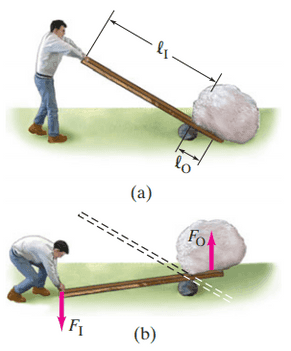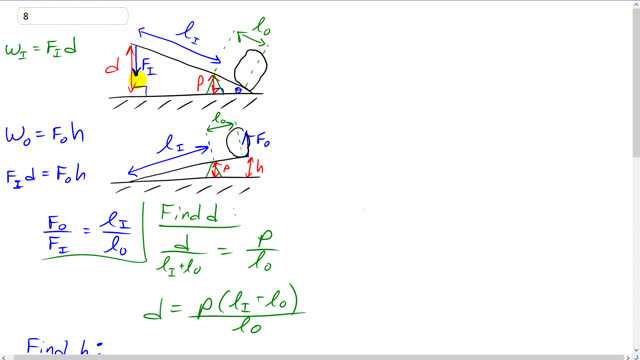
A lever such as that shown in Fig. 6–35 can be used to lift objects we might not otherwise be able to lift. Show that the ratio of output force, , to input force, , is related to the lengths and from the pivot by . Ignore friction and the mass of the lever, and assume the work output equals the work input.


In order to watch this solution you need to have a subscription.
This is Giancoli Answers with Mr. Dychko. This lever has a pivot here and there's an input lever arm measured from the pivot to the point where the input force is applied and it's gonna move down a height d. And so the work done by the input force is this vertical height d multiplied by this vertically downed force F I and since they are along the same line, they are parallel, you can just multiply them and not worry about any angles. And then the output force is gonna raise the rock up some height h and it will have a lever arm of l O. Now, we are gonna use similar triangles and we are gonna try to establish that this is true and we are given the piece of information that the work done by the input force so that's F I times d equals the work done by the output force. So that's the output force times the height h and we need to show the ratio of the output height to the input height equals the ratio of the input lever arm divided by the output lever arm. So, let's what we can say so far, you know, is we can say that F O divided by F I equals d over h but that's not good enough because we have to express it as l I over l O. So, that means we need to figure out other ways of expressing d and h and you can do that with similar triangles. So, let's first find d. So, d divided by this full-length here, which is l O plus l I is gonna equal the height of the pivot divided by l O. So, these are similar triangles so the ratio of corresponding sides are equal then because these triangles have all the same angles; it's a right triangle you know this big triangle here is a right triangle and same with this small triangle including the pivot is also a right triangle here and they both have a common angle so that means well, two angles are definitely equal, in which case, all three are equal and so we can divide the side opposite to Θ by the hypotenuse for both triangles and that ratio will be the same. That's similar triangles is what I use to get this equality here. And then we can solve for d by multiplying both sides by l I plus l O. So d equals the height of the pivot times l I plus l O divided by l O and then we can do the same sort of thing for h and we'll look at the second picture here; h divided by l O plus l I is gonna equal p divided by l I. So, this is the first triangle and we have the opposite side h divided by the hypotenuse l O plus l I and that equals the height P divided by its hypotenuse, which is just l I. And then make substitutions into this formula here for d and h. So, d is height of the pivot times l I plus l O all over l O and then h is P times l O plus l I divided by l I and when you do a bit of algebra, it works out to what we are supposed to show because these are common factors which will cancel on both sides. And you could divide both sides by F I and then multiply both sides by l I and l I cancels on the right and you have F O over F I and then you have l I over l O on the left side and switch the sides around and you get this. And there we go!